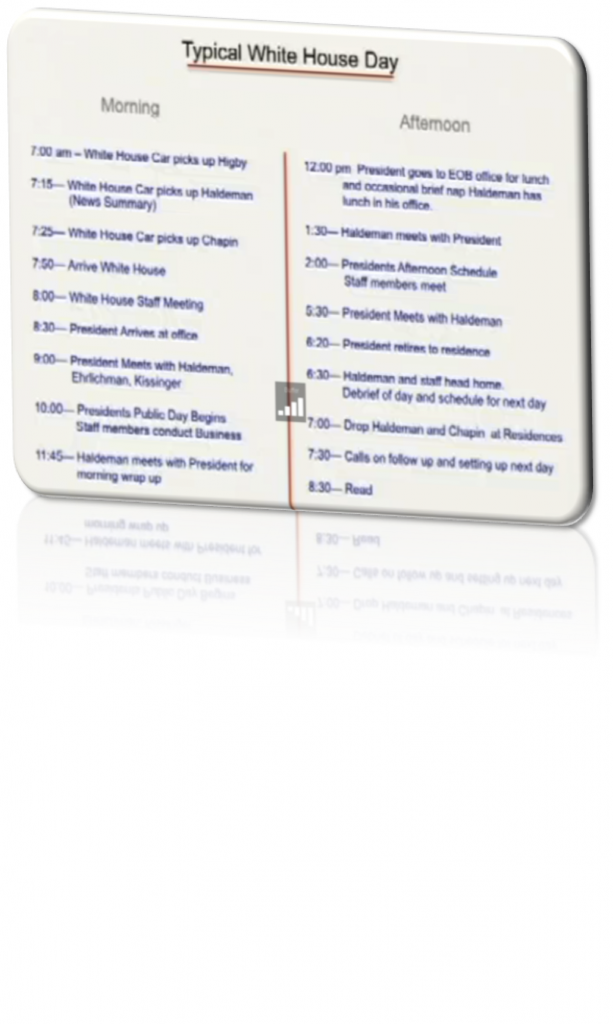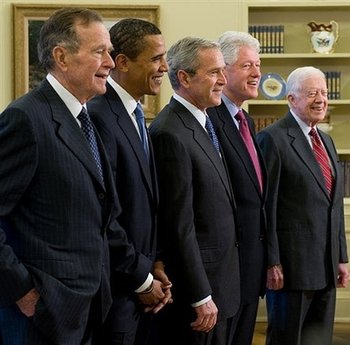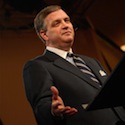 Richard Nixon”™s approach to running the West Wing reshaped the role of the Chief of Staff to the point that it is still largely used to this day in the Office of the President. Interestingly, Eisenhower had a Chief of Staff, but most decisions were made by Cabinet Secretaries. Kennedy did not have a Chief of Staff and operated in a more free style with no intentional chain of command as to how decisions were made. Nixon changed the approach so that decisions were made in the White House and executed then by Cabinet Secretaries. He divided White House responsibilities into 3 areas: Domestic Council, National Security Council, and the Office of the President.
Richard Nixon”™s approach to running the West Wing reshaped the role of the Chief of Staff to the point that it is still largely used to this day in the Office of the President. Interestingly, Eisenhower had a Chief of Staff, but most decisions were made by Cabinet Secretaries. Kennedy did not have a Chief of Staff and operated in a more free style with no intentional chain of command as to how decisions were made. Nixon changed the approach so that decisions were made in the White House and executed then by Cabinet Secretaries. He divided White House responsibilities into 3 areas: Domestic Council, National Security Council, and the Office of the President.
- Nixon wanted information mostly in written form and received it only from a few people with whom he would discuss it. They created the position of the Staff Secretariat who distributed the paper work appropriately.
- Trust was the most important commodity.
- Nixon was a very private person and preferred to consider succinct written proposals, summaries or analyses, with a few people.
- Decisions were made in the White House and Cabinet Secretaries executed those decisions.
- 7:30 a.m. was the start time for most White House senior officials.
- Nixon was careful with his public activities and focused on what would be the most significant issues.
- The president spent a tremendous amount of time on fewer things.
- Haldeman had a lack of ego, a passion for anonymity, but a self-confidence in his own ability. Trust and focus were his emphases.
- The story of the day, everyday, was “Think it Through!” Everything was thought through to the maximum.
- Every day at 2:00 p.m. the staff met for a communications strategy session on how to communicate their message through the media.
- The principles the staff used in organizing the President”™s time were
- One key public event per day
- Say “˜no”™ to everything. “˜Maybe”™ means yes.
- You can always reactivate an invitation.
- Generate your own events and ideas (Nixon”™s team was the pioneers of Photo ops).
- Arrive & Depart. Never stay for a whole event.
- When possible, use the Vice President or Cabinet officer vs. the President.
- Tone & Demeanor must be “presidential” at all times.
- When Possible, use the White House. No one else can.
- Most executives”™ time is driven by appointments and an in-box. Instead, Nixon focused on every event being a means to communicate something about his policies.
- A goal was to always seek achievement, not just a lot of activity.
- No one prepared harder than the President. Winston Churchill was Nixon”™s role model for preparation. “The hardest work he ever did was to prepare for spontaneous remarks.”
- Telephone calls were treated as formal appointments. Each had a purpose, talking points, outcomes which were outlined in a memorandum.
Nixon is obviously remembered for his extreme faults that led to his public demise. His inner demons eventually defeated his staff”™s efforts. But I think it is worth noting that Nixon entered the White House at a transitional time in Presidential history. In 1960 he had been defeated by Kennedy”™s more deft use of media and public persona, and when he eventually reached the White House, he understood the need to rework an ever increasing bureaucracy so that decisions could be streamlined and more effective.
He walked into the Presidency as means of media were exploding, when political maneuvering was escalating, and the need to maintain a handle on the message was tantamount in making political progress. In short, Nixon”™s administration may be remembered for its ultimate failure, but the changes he brought to the daily operations of the West Wing, the focus of the President”™s time, the use of media, and the reorganization of how the White House operated is still mimicked to this day.








Great post. I’ve been intrigued by this lecture ever since you mentioned it in one of our pastors conference-calls last year. Time is a valuable commodity, and it seems Nixon used it extremely well. I’d love to see a follow-up post on how you suggest we specifically apply these principles to pastoral ministry, including a sample daily schedule. I realize we pastors do not always have the luxury of structure and short appointments, but it seems like there is a lot we could learn from Nixon.